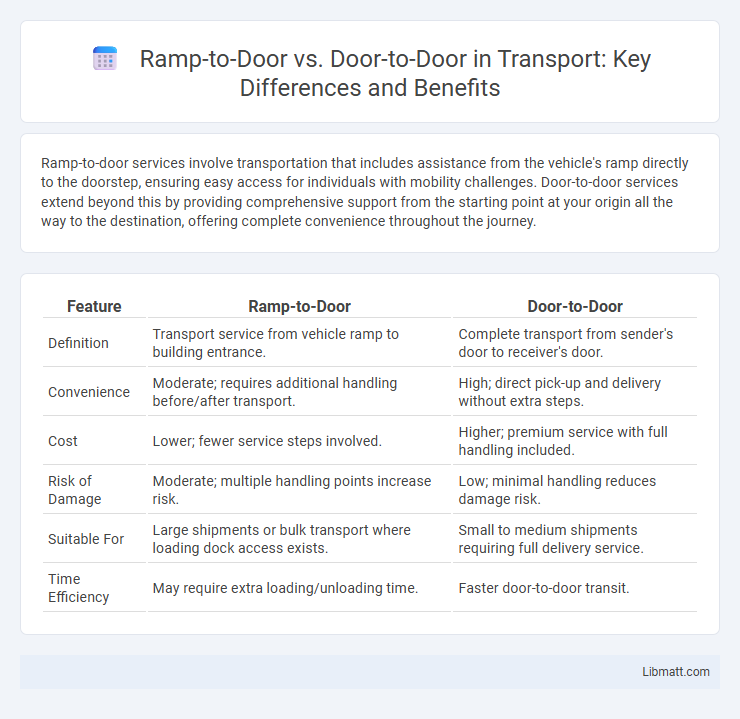Ramp-to-door services involve transportation that includes assistance from the vehicle's ramp directly to the doorstep, ensuring easy access for individuals with mobility challenges. Door-to-door services extend beyond this by providing comprehensive support from the starting point at your origin all the way to the destination, offering complete convenience throughout the journey.
Table of Comparison
| Feature | Ramp-to-Door | Door-to-Door |
|---|---|---|
| Definition | Transport service from vehicle ramp to building entrance. | Complete transport from sender's door to receiver's door. |
| Convenience | Moderate; requires additional handling before/after transport. | High; direct pick-up and delivery without extra steps. |
| Cost | Lower; fewer service steps involved. | Higher; premium service with full handling included. |
| Risk of Damage | Moderate; multiple handling points increase risk. | Low; minimal handling reduces damage risk. |
| Suitable For | Large shipments or bulk transport where loading dock access exists. | Small to medium shipments requiring full delivery service. |
| Time Efficiency | May require extra loading/unloading time. | Faster door-to-door transit. |
Introduction to Freight Delivery Methods
Ramp-to-door freight delivery involves transferring goods from a transportation vehicle onto a loading dock or ramp before final delivery, optimizing efficiency for warehouses equipped with such facilities. Door-to-door delivery provides a comprehensive service by transporting cargo directly from the sender's location to the recipient's address, eliminating the need for intermediate handling. Your choice between ramp-to-door and door-to-door methods depends on accessibility, cost considerations, and the specific needs of your shipment.
Defining Ramp-to-Door Services
Ramp-to-door services provide wheelchair users with transportation from the vehicle ramp directly to their destination's door, ensuring minimal mobility barriers during transit. This specialized service facilitates seamless access for passengers who require assistance beyond just boarding and alighting the vehicle. By focusing on the critical last step of the journey, ramp-to-door options enhance independence and safety for individuals with mobility challenges.
Understanding Door-to-Door Shipping
Door-to-door shipping involves the transport of goods from the sender's location directly to the recipient's address, ensuring a seamless delivery process without the need for handling at intermediate points. This method provides added convenience and security by minimizing the risk of damage or loss during transit. Understanding door-to-door shipping is crucial for businesses looking to streamline logistics, improve customer satisfaction, and reduce shipping complexities compared to ramp-to-door services.
Key Differences Between Ramp-to-Door and Door-to-Door
Ramp-to-door service involves delivery to the building's loading dock or ramp, requiring recipients to handle the final transfer of goods inside, while door-to-door service encompasses delivery directly to the recipient's specified indoor location. Ramp-to-door shipments are typically more cost-effective and suitable for large or freight items, whereas door-to-door ensures convenience and added handling but often incurs higher fees. The choice between the two depends on factors like shipment size, recipient capabilities, and budget constraints.
Cost Implications: Ramp-to-Door vs Door-to-Door
Ramp-to-door moving services typically cost less than door-to-door options because they require you to load and unload between the moving truck and your property, reducing labor and time expenses. Door-to-door services include handling your belongings from your old home directly to your new one, resulting in higher charges due to increased convenience and comprehensive labor. Your choice between these methods impacts the overall moving budget, balancing cost savings against the level of service and ease.
Transit Time Comparison
Ramp-to-door shipping generally offers faster transit times than door-to-door services because it involves fewer handling stages, reducing delays in the shipping process. Door-to-door shipping requires additional coordination for pickup and delivery at precise locations, which can extend transit times especially in congested urban areas or regions with limited access. For time-sensitive shipments, ramp-to-door services often provide a more streamlined and expedited option, minimizing transit duration from origin unloading ramps to the final destination door.
Security and Risk Management
Ramp-to-door shipments reduce handling points, minimizing exposure to theft or damage and enhancing overall cargo security. Door-to-door services involve multiple transfers, increasing the risk of loss or misplacement throughout the shipping process. Choosing ramp-to-door can streamline your risk management strategy by limiting vulnerable touchpoints during transit.
Suitability for Different Cargo Types
Ramp-to-door shipping is ideal for heavy, bulky, or oversized cargo such as construction equipment or large machinery that requires a forklift or loading ramp for safe handling. Door-to-door shipping suits smaller, palletized goods or parcels that can be easily managed by standard freight carriers or couriers, ensuring convenience and efficient delivery. Choosing the right option depends on cargo dimensions, weight, and handling requirements to optimize safety and cost-effectiveness.
Choosing the Right Option for Your Business
Selecting between ramp-to-door and door-to-door shipping depends on your business's logistical needs and budget constraints. Ramp-to-door services involve unloading at the delivery terminal, which can reduce costs but may require extra handling on your part. Door-to-door shipping provides full service from the origin to your doorstep, ensuring convenience and reducing the risk of damage, making it ideal for businesses prioritizing efficiency and reliability.
Conclusion: Which Delivery Method is Best?
Ramp-to-door delivery offers a cost-effective solution for large shipments requiring loading dock access, minimizing handling and damage risk. Door-to-door delivery provides greater convenience and speed, ensuring packages arrive directly at the recipient's location without extra steps. The best method depends on shipment size, handling needs, and customer preferences for efficiency versus convenience.
ramp-to-door vs door-to-door Infographic

 libmatt.com
libmatt.com